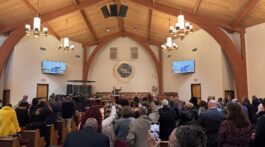Babylon–Who is she?
Christians in general have many ideas about the identity of Babylon, the scarlet woman who makes her followers drink her deadly wine (Revelation 14:8, 17:1-6). Some think Babylon is a symbol for a godless, wicked worldview. Others think it points specifically to papal Rome, or even to Protestantism or spiritualism. In truth, Babylon could include any or all of these ideas.
We know it is Satan’s delight to deceive us, and the way he has worked in the past is to make his false claims appear very close to God’s truth. So, it makes sense he would use a false belief system to spread his false lies about God.
There are some important tools for determining symbols in the Bible. First of all, whenever possible, we must let the Bible interpret itself. For instance, “woman” is used in the Bible to represent a religious institution, a church. The church is, after all, called the bride of Christ.
2 Corinthians 11:2 and Jeremiah 6:2 compare God’s pure, true church to a virgin woman. And Jeremiah at one time called backsliding Jerusalem a harlot woman for her unfaithful wandering away from God (Jeremiah 3:6). The city of Babylon then appears to be the antitype of the city of Jerusalem. Satan’s false religion versus God’s true church.

The most glaring sins that characterized ancient Babylon—its pride, idolatry, and blasphemy—no doubt describe the prevailing, secular culture around the world today. But, according to the Bible, Babylon is most likely a symbol of the backsliding Christian church, both during and after Rome’s long, papal rule, as most of the Protestant churches only partially reformed its erroneous beliefs and practices.
The world, of course, is drawn into this confusing, denominational quagmire of altered doctrines, steeped in human tradition, leaving us with a pretty broad picture of who Babylon is. But God, through this warning of the second angel, encourages every honest soul to come out of her, so they don’t partake of her plagues (Revelation 18:4).
Read the expanded view of the second angel’s message in Revelation 18:1-8. And just continue to love, follow, and worship God as He leads you through His word, no matter the cost.
When financial experts study counterfeit coinage and bills, they focus on knowing what true money looks like, instead of the false, counterfeit ones, of which there are many. Therefore, it makes sense to study more closely what God’s true church looks like than to dwell on Satan’s false religious systems. The next topic in our series will help us do that by looking at what a “saint” is, as mentioned at the end of the three angels’ messages (Revelation 14:12).
In the meantime, be sure and check out the previous articles in this series, Prophecy 101, Prophecy 102, Prophecy 103, and Prophecy 104. Especially if you are unsure about the time prophecies of 70-weeks, 1,260 days, or the 2,300 days. Or even if you question why they are important.
In these last days, we must not only be aware of these prophecies, but be willing to share them, as much as we are able! After all, they are part of the gospel for our times; in other words, present truth (2 Peter 1:12).










